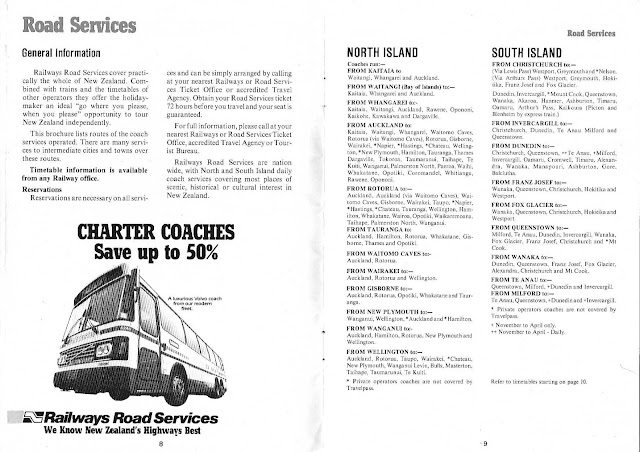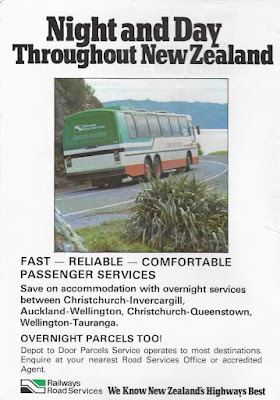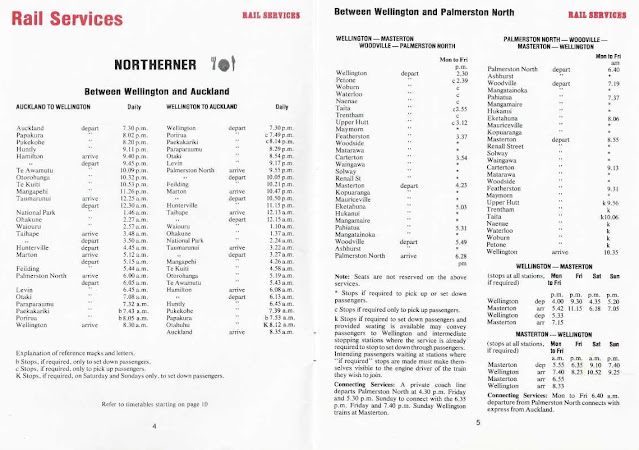Continuing a series of timetables is the summer 1983, autumn 1984 edition of the Railways Corporation timetable. This time I have included the NZR Road Services part of the timetable and will focus on the differences from the winter 1983 timetable (again apologies for my childhood doodling on it). Perhaps the only real difference on the front page is the new logo, the stylised NZR logo on an angle is meant to represent speed and movement more than the static logo. The static logo had its origins in the 1970s under the Railways Department so it was appropriate with the corporatisation on 1 April 1982 for there to be a more commercially oriented look to the Railways Corporation.
The inset and the first page below are virtually identical to the previous timetable, but with the new Road Services logo advertising the overnight coach services. My intention in publishing the full timetable is to show the sheer extent of NZR Road Services operations, which easily outstrip today's Intercity route and frequency structure, reflecting a time when coach services were much more integral to providing access to many smaller communities throughout the country. This was a time with lower per capita car ownership than was seen 10-15 years later when removal of tariffs on imported cars and easing of restrictions on used car imports saw the cost of buying a car drop significantly. The consequent reduction in car prices saw car ownership increase and the main effect of this was to see a dropping patronage for these services to uneconomic levels.

Unlike the previous edition, the Road Services general information does not come ahead of rail services, which much more conveniently are listed first with once again the Northerner and the Wellington-Masterton-Woodville-Palmerston North train, and Wellington-Masterton services listed. The Northerner timetable is virtually identical, except for some slight changes at the end of each direction's schedule, presumably reflecting changes in the suburban rail timetables in Auckland and Wellington in the morning peak. What IS odd is describing the next service as between Wellington and Palmerston North, when it was clearly not a service intended for such a trip (although there were no services around that time northbound, the Northerner wasn't that much different southbound). Otherwise that timetable is essentially unchanged, note the large number of on-request stops in the Wairarapa, including Tararua District.

Unlike the previous timetable, the Cook Strait Ferry service (not yet branded the Interislander) was kept from this page, and this time the Silver Fern Railcar actually had the refreshment logo included (yes I drew it on the last one). The Wellington-Gisborne express timetable has not changed, note that only on Sundays would the service stop on request at Shannon, Waikanae and Paekakariki (remember at this time the Wellington electric suburban rail system terminated at Paraparaumu, but had only just been extended from Paekakariki a couple of years before). Other than those stops, only Ormondville was on demand south of Napier, but most stops between Napier and Gisborne were on request only.
The Silver Fern timetable is largely unchanged except for a delay at the end of the Wednesday "Blue Fern" locomotive hauled carriage train service southbound.
Sensibly, the Cook Strait Rail Ferries are on this page with the connecting Christchurch to Picton express timetable. The ferry timetable over this period is varied in part because of the busy Christmas/New Year holidays period, as at the time the DEV Arahura had been introduced into service in December 1983, replacing the GMV Aramoana (the original Cook Strait Rail Ferry), but with that larger ferry and the fleet of the Aranui, Arahanga and Aratika, the four ferry service enabled quite an extensive timetable, with six return sailings on some days, reduced to four from early February 1984.
The Southerner timetable was notable for having a trial stop at Palmerston over the period of this timetable, as there was effort to attract back patronage from coach services. The Christchurch-Picton express timetable is unchanged, but note the number of on-request stops in Christchurch. The very locally oriented Christchurch-Greymouth express (which I caught at the time with my Dad once in each direction) had dropped the 0600 departure from Greymouth except on Saturdays, so there was now a daily service each morning (two separate trains) in each direction Monday to Saturday (Saturday it left Greymouth at 0600 enabling an earlier arrival in Christchurch), but with evening only services on Sundays, and Fridays offering the only day return service possible, as there were Friday daytime and evening services. This gave travellers (like my Dad and I) 3.5 hours to explore Greymouth before returning on the evening train (and stopping for a second, third or fourth pie(!) at Otira and Springfield on the way back).

In the previous timetable, this summary of NZR Road Services routes was on the second and third page, again this time with the new logo. Note that some routes are marked as not available by Travelpass, because they were provided by private operators (variably Newmans, Mt Cook Landline and H&H Coaches, all of which are long merged and gone).
The first detailed timetable for Road Services focuses on Northland, with two Auckland-Kaitaia services, one via SH1 and the other via SH10. Note two departures at 0115 (AM) for Kaitaia from Auckland, with the SH10 service clearly intended not for through travellers. Likewise a 0115 service for Dargaville. Was this always three coaches or sometimes two (or one) connecting elsewhere? The timetable seems to indicate they were separate services.

It's fairly clear the Whangarei-Auckland services include the ones going further afield, but this page is focused on two routes between Auckland and Wellington. These services obviously competed with the Silver Fern and the Northerner for some traffic at least. It indicates six daily services between Wellington and Auckland on the two routes, with the 7:00pm overnight Wellington to Auckland service being non-stop (except for pick ups in Porirua and Levin). This intensity of operation indicates demand for a lot of travel between stops, but also how this was a main means of budget travel at the time. Bear in mind domestic air services were, at the time, a monopoly of Air New Zealand with discounted airfares still relatively high. NZR Road Services was the means for those with the most limited means to travel internally.
These following pages focus on the Bay of Plenty and Gisborne. The Auckland-Gisborne service ran up to four times a day and was clearly focused on parcel delivery, with services leaving at 12:45am (arriving 12:40pm), leaving 08:25am, 09:15am and 9:15pm. The Gisborne-Opotiki service was all about servicing Tairawhiti communities. Auckland-Tauranga operated three times a day most days eastbound, but five times westbound!
Auckland-Whitianga saw the Coromandel Peninsula well served, albeit with most services being other routes stopping at Thames only. Wellington-Rotorua-Tauranga was a well publicised service as it had no rail competition, but only the overnight service went the whole way. The Auckland-Napier service may not have been NZR Road Services the whole route, as Mt Cook Landlines operated the route as well.
Wellington-Wanganui-New Plymouth was a core NZR Road Services route since the Blue Streak service was scrapped in 1977. Around five daily services on the route indicates significant patronage, with three leaving in the morning, one in the afternoon, and an evening service, add a second evening service to Wanganui only, a daily Wanganui-New Plymouth service, and a daily Hawera-New Plymouth service, and you have quite the intensity of coach services.
Few will know that NZR Road Services ran coaches competing with the rail service between Wellington and Masterton, with three services each way on weekdays. Although two of those were at times when trains did not operate.
Down south the Christchurch to Westport or Greymouth via Lewis Pass service was intended to serve locations not accessible by the rail service. It included services only to and from Hanmer Springs, as well as a daily service to Westport, and a morning service from Greymouth to Westport then Christchurch.
The Christchurch-Kaikoura coach was only four days a week at times that did not parallel the rail service, whereas the twice daily Akaroa service harked from the days when Little River Branch had passenger rail which connected to a coach to Akaroa.

As with Auckland-Wellington, despite having rail service, NZR Road Service ran multiple coach services daily between Christchurch, Dunedin and Invercargill. Two services ran most days the whole route. The daytime service was always designed to parallel the Southerner so passengers could ride the Southerner to a major station (e.g. Timaru or Gore) and catch the coach to smaller centres, with the overnight service replacing the former overnight rail service. Notable were two additional services between Christchurch and Dunedin most days and another two between Dunedin and Invercargill, designed to meet demand at different times. The Christchurch to the Glaciers coach service went over Arthurs Pass in the days of the zig zag route on SH73. This nearly 10 hour coach service was quite a run, but did ensure tourists could get to the glaciers cheaply. The Westport to the glaciers services was once daily, but there were three daily services between Greymouth and Hokitika.

This page is primarily Dunedin and Queenstown focused coach services, with twice daily services Dunedin-Queenstown via Roxburgh and Cromwell. A daily service from Dunedin to Wanaka via Cromwell, as well as a regular Dunedin-Ranfurly-Cromwell service which essentially replaced the railcar service on the Otago Central Railway line (still open but only for freight at the time), which had been cancelled in 1978. Queenstown to the Glaciers plugged the Haast Pass gap (at the time SH6 over Haast Pass was a very unpleasant unsealed route, so was a gruelling 9hr 15min coach trip). A daily Dunedin-Milford and a second service Dunedin-Te Anau only added to the completeness of service in Otago. The Dunedin-Lumsden-Queenstown service sought to serve parts of Southland away from the Southerner service, but also provide the connection that replaced rail from Lumsden to Kingston and on to Queenstown.

The final timetable pages depict the Invercargill-Milford daily service (not a day return by any means) and the Invercargill-Queenstown service which enabled tourists to go south and join the Southerner the following day. It also included the day return services from Queenstown and Te Anau to and from Milford. Finally, the map depicting rail, ferry and major coach routes with notable gaps northwest from Hawke's Bay and inland Canterbury/Mt Cook (Mt Cook Landline country) and Nelson, north of New Plymouth (Newmans).
On the back cover is the Travelpass ad similar to the previous timetable, with the same price as before, noting there was a Price and Wage Freeze applicable at the time (the final term of the Muldoon led National Government). 15 days at $180, 22 days at $240, both extendable at $15 per day.




























